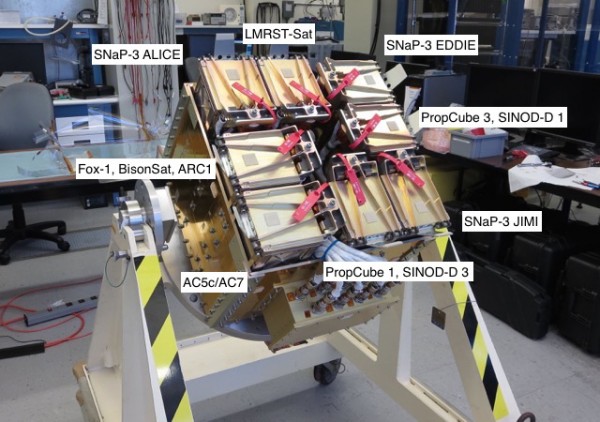–‘”˚…Á students track launch of satellite they built
October 8, 2015
Sue Mitchell
907-474-5823
A small research satellite designed and built by University of Alaska Fairbanks students is among 13 launched early Thursday morning from Vandenberg Air Force Base in California.
The tiny satellite, known as a cubesat, flew on the NASA National Reconnaissance Office’s Government Rideshare Advanced Concepts Experiment, or GRACE.
The Alaska Research CubeSat, called ARC-1, was the culmination of a –‘”˚…Á Alaska Space Grant Program project five years in the making and the result of work by a whole team of students, as well as collaborations between the College of Engineering and Mines and the Geophysical Institute. –‘”˚…Á engineering students Patrick Wade and Matt Pacheco hand-delivered the tiny satellite, just under 4 inches square, to California Polytechnic State University in San Luis Obispo for incorporation into the rocket payload last March.
Work on the project started in 2009 under the tutelage of Denise Thorsen, director of ASGP and faculty advisor to the Space Systems Engineering Program at –‘”˚…Á. NASA developed the CubeSat Launch Initiative as a way to give universities access to space. Because they are so small, multiple cubesats can be packed in a rocket used to deploy a larger satellite.
Similar to NRO’s previous cubesat rideshares, GRACE will reach orbit on an ATLAS V rocket, mounted to the aft-bulkhead carrier, located on the aft end of the Centaur upper stage. GRACE will carry a total of 13 cubesats, nine sponsored by the NRO and the four sponsored by NASA’s CubeSat Launch Initiative. The cubesats are ejected into space once the primary payload is safely on its way.
The team has turned down previous possible launch dates because the orbit wouldn’t get the satellite to a high enough latitude in order to communicate with it from Fairbanks, Thorsen said. “There’s no sense in having a satellite we can’t talk to.”
This launch will put ARC-1 in an elliptical orbit at a latitude just north of Fairbanks and between about 500 and 310 miles from Earth.
ARC-1 will perform three tasks during its roughly one-year lifespan. An experiment activated at liftoff will collect data about temperature and vibration inside the rocket. The students will also evaluate a novel, low-power attitude control system they developed, and a camera will transmit back images of snow and ice cover. The students will track ARC-1 at the NOAA and NASA Fairbanks Command and Data Acquisition Station at Fox, which hosts a ground station for the students.

Once ejected from the rocket, ARC-1 will begin transmitting a beacon on a ham radio frequency. Any ham radio users around the world who pick up the signal will be asked to send an email message to Thorsen stating when and where they picked up the signal. Thorsen will send each respondent what‚Äôs called a QSL card ‚Äî a written acknowledgement and thanks for the information. Once the ARC-1 orbit is accurately characterized and the cubesat is being tracked, the –‘”˚…Á students will instruct the satellite to transmit information on a specific radio frequency.
“The main goal of our cubesat was to monitor the rocket launch environment on the ride up,” Thorsen said. “Our cubesat will collect that data and store it. Once we have proved out the health of the cubesat and it tells us how much data it collected, then we will give it the command to start downloading that data.”
Information about how well the novel satellite attitude control project is going will be part of the beacon, Thorsen said.
“When ARC-1 is kicked out of the rocket, it’s tumbling, we can tell that by the beacon data,” Thorsen said. “Over time we hope the tumbling will stop and the satellite will be pointed in a particular direction.” All the control and attitude adjustments are preprogrammed into the cubesat.
Thorsen said 36 –‘”˚…Á students have worked on this satellite since the project‚Äôs inception. Five were graduate students, another five started as undergraduates who became graduate students. Thirty-two of the students who‚Äôve worked on the project were undergraduate students. Two of the 36 were high school students; one of these is now a freshman at –‘”˚…Á.
Five students attended the launch at Vandenberg Air Force Base: Jesse Frey, Morgan Johnson, Chic O’Dell, Patrick Wade and Matt Pacheco. Thorsen and a graduate student will monitor the launch from Alaska.
The team used facilities within the College of Engineering and Mines and at the Geophysical Institute to make sure the Alaska Research CubeSat met NASA specifications.
ADDITIONAL CONTACT: Denise Thorsen, 907-474-7052, dlthorsen@alaska.edu
ON THE WEB:


